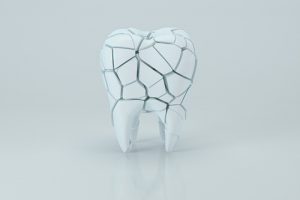The term cracked root canal tooth is enough to make many of us wince in sympathy. We understand the discomfort and the concern that comes with it. But how does a tooth that’s undergone a root canal end up cracked? What does this mean for the individual’s oral health? These are pressing questions that many patients and even dental professionals grapple with.
Throughout this article, we’ll unravel the mystery behind the cracked root canal tooth, exploring its symptoms and the subsequent steps one might need to take. Prepare yourself for a journey that dives beneath the surface of dental procedures, bringing forth insights you might never have anticipated. Explore in more detail.
How does a root canal cracked tooth happen
A cracked root canal tooth refers to a tooth that has previously undergone a root canal treatment and has subsequently developed a crack or fracture. Root canal treatment involves removing the tooth’s inner pulp and nerve and sealing it to prevent infection.
Despite this procedure strengthening the tooth, it can sometimes become more brittle over time. As a result, the tooth may become susceptible to cracks or fractures due to various factors, such as biting on hard substances, trauma, or even the natural aging process of tooth structure. Recognising and promptly addressing a cracked root canal tooth is vital, as it can lead to complications like infections or further structural damage.
Types of cracked teeth
Cracked teeth, while seemingly straightforward, can present in several distinct manners. Understanding these variations is pivotal for effective diagnosis and early treatment. Here’s a breakdown of the different types of cracked teeth:
- Craze Line: A minor crack that only affects the tooth’s outer enamel. Typically, these do not cause pain and are considered a cosmetic concern.
- Fractured Cusp: This occurs when a piece of a tooth’s chewing surface breaks off, usually near a filling. It doesn’t usually affect the pulp or cause much pain but weakens the tooth.
- Cracked Tooth: This type of crack extends from the tooth’s chewing surface and progresses vertically towards the root. If not treated promptly, the crack can extend further, leading to complications.
- Split Tooth: A more severe form where the tooth has been segmented into two distinct parts due to the crack. Immediate attention is needed to save any remaining portion of the tooth.
- Vertical Root Fracture: Starting at the root and moving upwards, this crack is often challenging to detect and can lead to severe pain and gum infections.
Recognising these variations is crucial for dentists and patients to ensure effective care and intervention.
What is the cracked tooth syndrome?
Cracked Tooth Syndrome (CTS) is a dental condition where a tooth has developed a hairline crack, often invisible to the naked eye and sometimes even undetectable in X-rays. These minuscule fractures, predominantly in the tooth’s chewing surfaces, can cause discomfort or intermittent pain, especially when biting down or consuming hot or cold foods and beverages.
The elusive nature of these cracks makes diagnosis challenging. If left untreated, CTS can progress, leading to further complications, including damage to the tooth’s pulp or even more extensive fractures.
As such, early detection and intervention by a dental professional are crucial to managing and mitigating the potential repercussions of this condition.
Root canal cracked tooth symptoms
Root canal cracked tooth is a condition that can emerge even after undergoing meticulous dental procedures. But how does one identify this dilemma? Being acquainted with its symptoms is paramount.
Onset Pain and Discomfort:
One of the hallmark symptoms of a root canal cracked tooth extraction is pain. Unlike a consistent pulse, the discomfort is often sporadic, manifesting primarily when biting down on food. This intermittent pain can baffle individuals, as it might dissipate before re-emerging without warning.
Sensitivity to Temperature:
Another notable sign is heightened sensitivity to temperature variations. Consuming hot or cold beverages might trigger a sharp, sudden pain, hinting at the possibility of an underlying crack.
Tenderness in the Gums:
Around the affected tooth, the gums might exhibit signs of distress. This can range from mild tenderness to pronounced inflammation, indicative of the tooth’s compromised state.
Difficulty in Pinpointing the Pain:
Often, individuals find it challenging to discern the exact source of their discomfort. This elusive pain, which might feel shifting or diffused, can be a classic symptom of a root canal cracked tooth.
In the ever-evolving narrative of dental health, recognising these symptoms plays a pivotal role. Knowledge, in this case, can be the bridge between early intervention and prolonged suffering. If any of these signs resonate with your experience, it would be judicious to consult a dental professional promptly.
Treatment of tooth cracks from root canal treatment
It’s apparent that teeth aren’t impervious to cracks even after the precision of root canal treatments. Addressing these cracks promptly is paramount to maintaining optimal oral health, and understanding the available treatments is the first step in this journey.
Dental Bonding:
For superficial cracks, dental bonding can be a viable solution. Using a resin material matched to the natural colour of the tooth enamel, the dentist meticulously binds it to the affected area. Not only does this seal the crack, but it also restores the tooth’s aesthetics. Find out more.
Crowns:
When the tooth’s structural integrity is jeopardised due to further damage to the crack, a crown often becomes the treatment of choice. Acting as a protective cap, it encases the tooth, providing strength and stability while preserving its appearance.
Root Canal:
In scenarios where the crack extends into the pulp of the tooth, a repeat root canal treatment might be necessitated. This ensures that any infected or inflamed pulp of the broken tooth is removed, alleviating pain and preventing further complications.
Extraction:
In the most severe cases, where the crack extends below the gum line or compromises the tooth’s foundation, extraction might be the only recourse. Following this, dental implants or bridges can be a dental implant is considered to replace the extracted tooth. Get more details.
Embarking on the path of dental treatments can be daunting. However, armed with knowledge and guided by professional advice, one can navigate the challenges posed by tooth cracks post-root canal treatment. If faced with such concerns, a timely consultation with a dentist will ensure the best course of action, safeguarding both your smile and your well-being.
How to eliminate pain symptoms
 Alleviating pain symptoms is paramount for both immediate relief and long-term well-being. Pain, often our body’s alarm bell, can vary in intensity and duration, but understanding its nuances and effective management techniques can significantly improve one’s quality of life. Here are some concise strategies:
Alleviating pain symptoms is paramount for both immediate relief and long-term well-being. Pain, often our body’s alarm bell, can vary in intensity and duration, but understanding its nuances and effective management techniques can significantly improve one’s quality of life. Here are some concise strategies:
- Over-the-counter Medications: Non-prescription analgesics, such as paracetamol or ibuprofen, can offer immediate relief for many types of pain. Always adhere to the recommended dosage and consult a pharmacist or doctor if unsure.
- Topical Treatments: Gels, creams, and patches infused with pain-relieving compounds can be directly applied to the affected area, offering targeted relief, especially for muscular and joint pains.
- Physical Therapies: Techniques like physiotherapy, massage, or chiropractic adjustments can effectively address pain stemming from musculoskeletal issues, enhancing mobility and function.
- Mind-Body Techniques: Approaches like meditation, deep breathing exercises, and guided imagery can help manage chronic pain by redirecting the focus and reducing stress.
- Consultation: Persistent or severe pain should always be addressed. Seeking advice from a medical professional can shed light on underlying causes and guide one towards specialised treatments.
In the intricate dance of pain and relief, being equipped with knowledge and proactive measures can make all the difference. Addressing pain holistically, considering both physical and mental aspects, ensures a comprehensive approach to well-being.
Signs of failed root canal
Root canal treatments, while highly effective, are not immune to complications. Even with the meticulous care of dental professionals, there are instances where a full root canal procedure might fail to achieve its desired outcome. Recognising the signs of a failed root canal is crucial to seeking timely intervention and ensuring the health of the affected tooth. Here are some key indicators:
- Persistent Pain: Continuous or recurring pain long after the procedure could suggest unresolved infection or inflammation within the tooth.
- Swelling: Noticeable swelling in the surrounding gum area, which might also be tender to touch, can be a red flag.
- Tooth Discolouration: An internal infection or the breakdown of internal filling materials can cause the tooth to take on a greyish hue.
- Return of Infection: A pimple or abscess on the gums, often called a sinus tract, indicates a recurring infection.
- Loose or Broken Filling: The filling or crown placed after the root canal treatment should be intact. If it becomes loose or breaks, it might expose the tooth to new infections.
When navigating the path of post-root canal care, vigilance in spotting these signs ensures that any complications are addressed promptly. Should any of these symptoms emerge, it’s imperative to consult a dentist to discuss potential remedies and prevent further complications.
Conclusion
In wrapping up, it’s evident that understanding the nuances of a cracked root canal tooth is indispensable for maintaining optimal dental health. Not only does it equip individuals with the knowledge to seek timely intervention, but it also underscores the importance of regular dental check-ups and proactive care.
As dental technology and treatments evolve, being vigilant about symptoms and armed with information ensures the longevity of dental crowns and our smiles. If you suspect or encounter any signs of a cracked root canal tooth, remember that early detection and professional advice can make all the difference in navigating this dental challenge.
Are you facing challenges with a cracked root canal tooth? Don’t wait and let the problem escalate. Your oral health deserves immediate attention. Call us now at (08) 9783 9006. At Emergency Dentist Perth, we’re always ready to assist and provide the expert care your teeth need. Don’t delay; your dental well-being is just a call away!
References
Cracked Teeth
https://www.aae.org/patients/dental-symptoms/cracked-teeth/
Cracked Teeth: Distribution, Characteristics, and Survival after Root Canal Treatment
https://pubmed.ncbi.nlm.nih.gov/26944835/
Fractured Tooth (Cracked Tooth)
https://my.clevelandclinic.org/health/diseases/21628-fractured-tooth-cracked-tooth
Chipped, broken or cracked tooth
https://www.nhs.uk/conditions/chipped-broken-or-cracked-tooth/
Cracked Tooth
https://www.healthline.com/health/cracked-tooth



Recent Comments